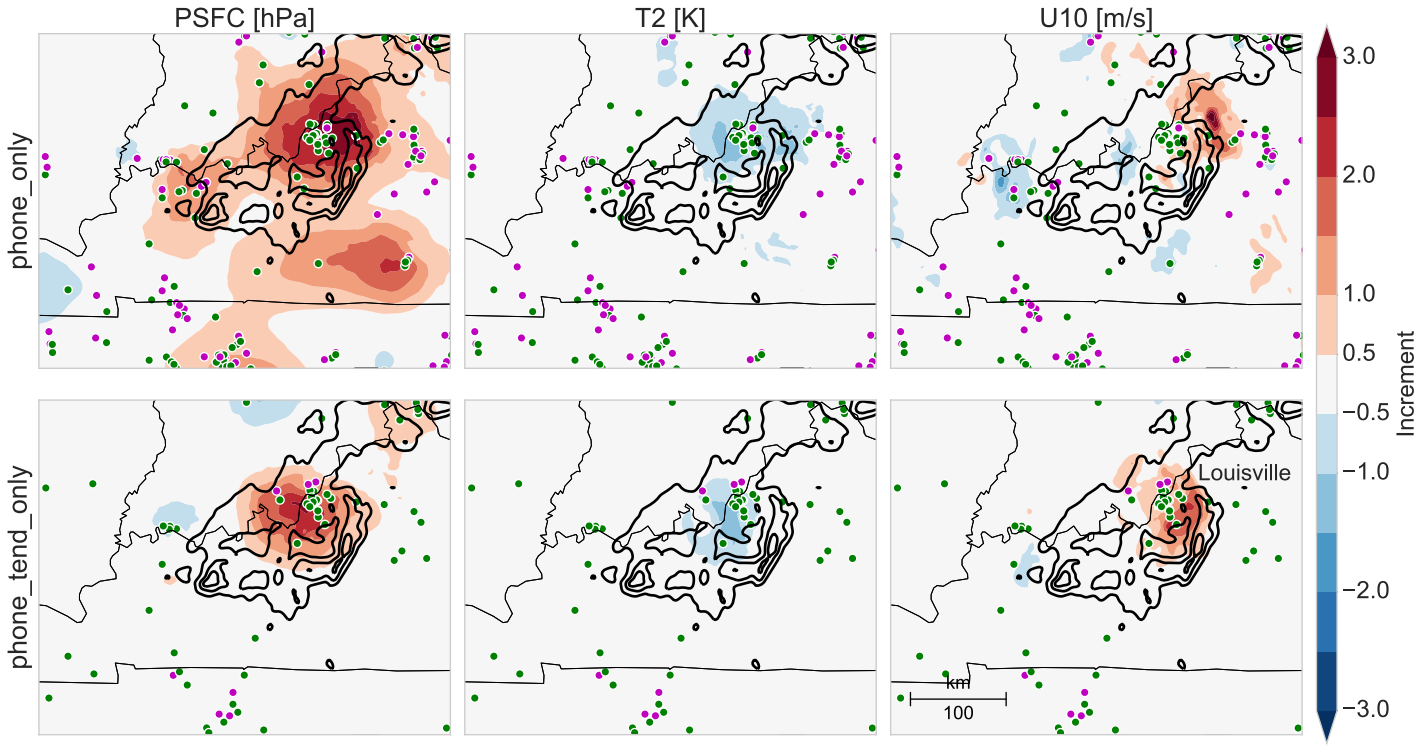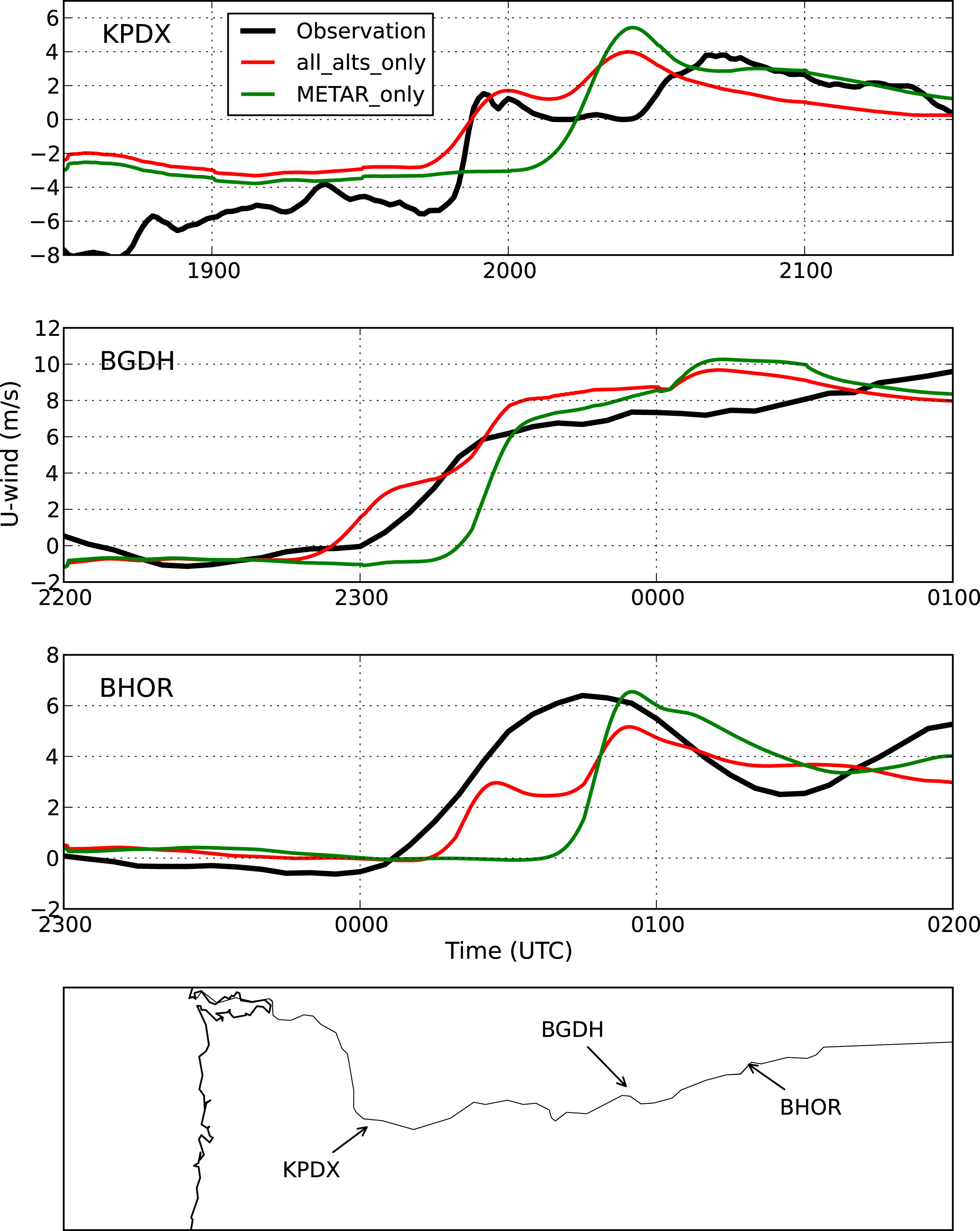Using Crowdsourced Observations for Mesoscale Weather Forecast Improvement
Ongoing and recent work at NCAR and the University of Washington with Dr. Cliff Mass and Conor McNicholasResearch Overview
Weather forecasts are ever increasing in both spatial resolution and the frequency with which they are updated with new observational information. Though our simulations can now resolve features as small as individual thunderstorms, the weather community needs weather observations at higher spatial densities and frequencies than currently available to properly initialize and verify our simulations on those fine scales. The growth of connected sensing devices in recent years offers a large, untapped source of observational resources we could use to improve weather prediction. However, with these non-traditional observation platforms come unique challenges. My crowdsourced observation work seeks to answer:- What kinds of potential crowdsourced observation platforms are out there, both now and in the future? How accessible are they, and what sorts of weather-relevant sensors are available?
- What are the unique error characteristics of observations in these non-traditional networks and how can we account for them?
- Can other observations beyond standard weather variables (e.g., beyond temperature, pressure, etc.) be used to provide useful weather information to improve prediction or verify forecasts?
- How can crowdsourced observations be leveraged to meet the unique weather needs of the providers of these observations?
Smartphone Pressure Observations
Most modern smartphones (since ~2012) have a barometric pressure sensor within them that can be accessed by apps running on the phone. We partnered with several app developers to collect pressure observations from a small subset (<1% in the United States) of these phones and have been evaluating their usefulness. The relative accuracy of the sensors are good, capable of measuring pressure variations on the order of 1-10 Pascals. However, most phones have significant biases and stringent quality control is required to make the observations usable.What can we do with smartphone observations?
I have tested the effect of assimilating pressure observations and one-hour pressure tendency observations from phones with small biases in a modern convection-allowing ensemble system. The results show that, even without bias correction, the available smartphone observations can capture large mesoscale weather features (>120 km in scale). One example is shown above, where smartphone observations (the dots) are sampling the cold pool behind a squall line that moved through Louisville, KY in 2015 (black contours are radar reflectivity). The ensemble system feasibly increases the pressure, decreases the temperature, and alters the wind field in response to the smartphone observations.Ongoing work includes additional partnerships with other app developers to continue to expand the number of smartphone observations we can acquire. You can help by downloading the uWx app (available for Android phones) developed by Conor McNicholas at the University of Washington to help us understand and correct for the bias characteristics in these phone observations. There are also plans to deploy smartphones equipped with these weather-monitoring apps in upcoming field campaigns to understand how these phones may sample a wide variety of mesoscale features.
Citizen "Backyard" Weather Stations
A number of weather enthusiasts and private companies own private weather stations and regularly submit the observations from these stations to online repositories. I acquired observations from the Weather Underground and the Citizen Weather Observer Program (CWOP) and evaluated the contributions of these observations to improved ensemble forecasts over the Pacific Northwest in 2011 and 2012.I showed these observations could improve 0-9 hour forecasts of a variety of mesoscale features, such as convergence zone precipitation and the timing of wind shifts associated with frontal passages. One example of this is shown in the figure at the right, where the timing of wind shifts along the Columbia River gorge was improved when the citizen pressure observations were assimilated. This demonstrates the utility of these observations for improved wind energy forecasts. These observations are being further considered in the ongoing WFIP2 project in the Pacific Northwest.
Publications and Presentations
Publications Relating to Crowdsourced Observations
Madaus, L. and C. Mass (2017): Evaluating Smartphone Pressure Observations for Mesoscale Analyses and Forecasts. Wea. Forecasting. In Press. doi: http://dx.doi.org/10.1175/WAF-D-16-0135.1.Madaus, L., G. Hakim and C. Mass (2014): Utility of Dense Pressure Observations for Improving Mesoscale Analyses and Forecasts. Mon. Wea. Rev.. 142, 2398-2413. doi: http://dx.doi.org/10.1175/MWR-D-13-00269.1.
Mass, C. and L. Madaus (2014): Surface Pressure Observations from Smartphones: A Potential Revolution for High-Resolution Weather Prediction? Bull. Amer. Meteor. Soc.. 95, 1343-1349. doi: http://dx.doi.org/10.1175/BAMS-D-13-00188.1.
Links to Presentations Given About Crowdsourced Obsservations
- Poster Presented at the 28th Conference on Weather Analysis and Forecasting/24th Conference on Numerical Weather Prediction (Seattle, WA, Jan 2017). PDF Here

